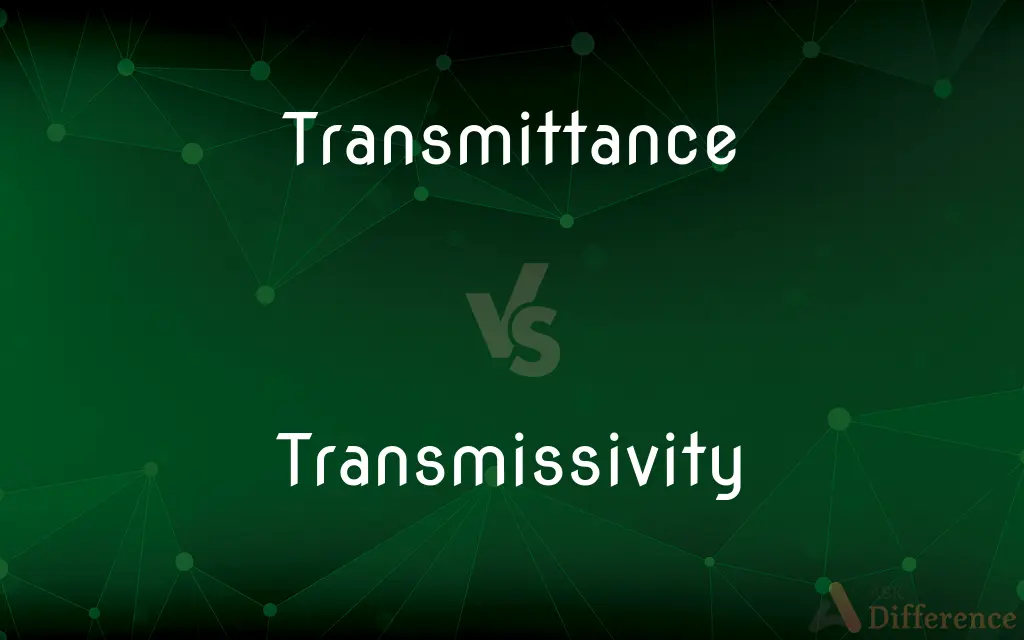Transmittance vs. Transmissivity — What's the Difference?
By Maham Liaqat & Fiza Rafique — Updated on March 30, 2024
Transmittance measures the fraction of light that passes through a material, while transmissivity describes the material's ability to transmit light without absorption.

Difference Between Transmittance and Transmissivity
Table of Contents
ADVERTISEMENT
Key Differences
Transmittance is a ratio, typically expressed as a percentage, of the intensity of light that passes through a material compared to the incident light on the material. On the other hand, transmissivity is a property of the material itself, indicating how well it allows light (or other forms of electromagnetic radiation) to pass through without being absorbed.
While transmittance is a measurement that can vary depending on the thickness of the material and the wavelength of the light, transmissivity is an inherent material property and does not change with material thickness or light wavelength.
Transmittance is often used in the context of specific experiments or applications, requiring an understanding of how much light gets through a material under certain conditions. Transmissivity, however, is used to characterize materials in a more general sense, regardless of the specific conditions of light incidence.
In the field of optics, transmittance is crucial for designing lenses and filters where the exact amount of light passing through is important for the system's performance. Conversely, transmissivity is significant in material science for selecting materials based on their optical properties for various applications.
Comparison Chart
Definition
Ratio of transmitted light to incident light on a material.
Material's ability to transmit light without absorption.
ADVERTISEMENT
Expression
Expressed as a percentage or decimal.
Inherent property, not usually expressed as a percentage.
Dependency
Depends on material thickness and light wavelength.
Inherent property, independent of material thickness or wavelength.
Measurement
Measured for specific conditions and applications.
Characterizes material properties in general.
Application
Important in optics for lenses and filters design.
Crucial in material science for material selection.
Compare with Definitions
Transmittance
Light Passage Measurement.
The transmittance of the glass was measured to determine how much light it lets through.
Transmissivity
Inherent Characteristic.
Materials with high transmissivity are preferred for transparent components in construction.
Transmittance
Ratio of Intensity.
A high transmittance value indicates that the material is highly transparent.
Transmissivity
Independent of Thickness.
The transmissivity of a material remains constant, regardless of its thickness.
Transmittance
Optical Property.
The optical transmittance of lenses affects their performance in optical devices.
Transmissivity
Not Measured in Percentages.
Unlike transmittance, transmissivity is not typically expressed as a percentage but understood as an inherent quality.
Transmittance
Quantitative Assessment.
The transmittance of the filter was 95%, allowing most of the light to pass through.
Transmissivity
Significance in Design.
Selecting materials with the right transmissivity is crucial for energy-efficient window design.
Transmittance
Variable with Conditions.
Transmittance varies with the thickness of the material and the wavelength of light.
Transmissivity
Material Property.
The transmissivity of clear plastic makes it suitable for light-transmitting applications.
Transmittance
Transmittance of the surface of a material is its effectiveness in transmitting radiant energy. It is the fraction of incident electromagnetic power that is transmitted through a sample, in contrast to the transmission coefficient, which is the ratio of the transmitted to incident electric field.Internal transmittance refers to energy loss by absorption, whereas (total) transmittance is that due to absorption, scattering, reflection, etc.
Transmissivity
(physics) A measure of the capacity of a material to transmit radiation (the ratio of the amounts of energy transmitted and received)
Transmittance
A transmission.
Transmissivity
(geology) A measure of the capacity of a saturated aquifer to transmit water horizontally. SI units: m²/s. Symbol: T.
Transmittance
(Physics) The ratio of the radiant energy transmitted to the total radiant energy incident on a given body.
Transmittance
A transmission
Transmittance
(physics) the fraction of incident light, or other radiation, that passes through a substance
Transmittance
Transmission.
Transmittance
The fraction of radiant energy that passes through a substance
Common Curiosities
How do you measure transmissivity?
Transmissivity is not directly measured but is a characteristic derived from the material's ability to transmit light without absorption.
Can a material be transparent but have low transmissivity?
No, a transparent material by definition has high transmissivity, allowing light to pass through with minimal absorption.
Why is transmittance important in optical applications?
In optical applications, knowing the transmittance is crucial for designing systems that require precise control over light transmission.
Can transmissivity change with material thickness?
No, transmissivity is an inherent property of the material and does not change with thickness.
How does wavelength affect transmittance?
Transmittance can vary with the wavelength of light, as materials may absorb or transmit different wavelengths differently.
How do manufacturers use transmissivity in product design?
Manufacturers consider transmissivity to select materials that meet the specific light transmission requirements of their products, such as for lenses, windows, or solar panels.
Can two materials with the same transmissivity have different transmittances?
Yes, if the materials are of different thicknesses or if the light used has different wavelengths, their transmittances can differ even if their transmissivities are the same.
Is transmissivity relevant for all types of electromagnetic radiation?
Yes, transmissivity is relevant for all types of electromagnetic radiation, not just visible light, including infrared, ultraviolet, and others.
What does a high transmittance indicate about a material?
High transmittance indicates that a material allows a large portion of light to pass through it.
What role does transmissivity play in energy efficiency?
Materials with high transmissivity for visible light and low transmissivity for ultraviolet and infrared light are key for energy-efficient designs, particularly in buildings.
Share Your Discovery

Previous Comparison
Reggaeton vs. Reggae
Next Comparison
Shrink vs. StretchAuthor Spotlight
Written by
Maham LiaqatCo-written by
Fiza RafiqueFiza Rafique is a skilled content writer at AskDifference.com, where she meticulously refines and enhances written pieces. Drawing from her vast editorial expertise, Fiza ensures clarity, accuracy, and precision in every article. Passionate about language, she continually seeks to elevate the quality of content for readers worldwide.















































